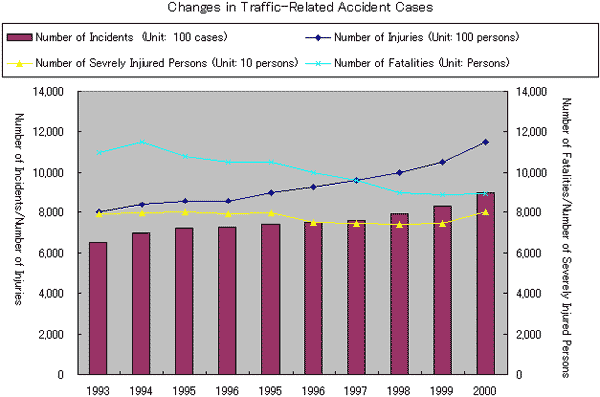Statistics on Traffic Accidents in 2000 Announced
Source: Safety and Health Newsletter 2001.3.5 No.612
Issued by: Japan Industrial Safety and Health Association
According to a report by the National Police Agency on traffic accidents that occurred during 2000, the number of incidents and injuries both sharply increased by about 10 percent, registering the worst record. While the number of fatalities has fallen for four consecutive years since 1996 when the number slipped below 10,000 persons, this figure increased for the first time in five years.
(1) Number of incidents: 931,934 cases (increase over 1999: 81,571 cases, increase by 9.6%)
(2) Number of fatalities: 9,066 persons (increase over 1999: 60 persons, increase by 0.7%)
(3) Number of injuries: 1,155,697 persons (increase over 1999: 105,300 persons, increase by 10.0%)
The statistics announced at the same time also revealed that the number of traffic accidents occurring on expressways during 2000 was 14,323, an increase of 10.3 percent over 1999. The number of fatalities due to such accidents was 367 persons, 13.6 percent up over the previous year, and the number of fatalities and injuries was 23,548 persons, an increase of 10.0 percent.
The report also revealed the major features of traffic accidents as described below.
(1) There were still many accidents in which cars were rear-ended and/or front-ended in collisions.
According to the type of accident, those involving car vs. car accidents registered the largest number of 792,846 cases, and accounted for 85.1 percent of all traffic accidents occurring during 2000. Especially, the ratio for rear-end collisions (29.7% of the total) and that for front-end collisions (26.5% of the total) were high.
(2) Fifty percent of the accidents in which cars were front-ended occurred at intersections without signals in urban areas.
If traffic accidents in which cars were front-ended are classified by topography and road shape, 91.5 percent of such accidents occurred at intersections. Especially, the incidence of accidents at intersections without signals in urban areas was high (52.6% of the total). Compared to the statistics for 1999, the number of accidents increased in both urban and non-urban areas, and an especially significant increase (by 9,269 cases; 7.7%) was seen in accidents at intersections without signals in urban areas.
(3) According to the classification by danger recognition speed (a speed at which a driver recognizes danger), accidents at a speed of 50km/hour or less increased.
An especially significant increase was seen for speeds of 30km/hour or less. Moreover, another feature is that the number of accidents at 81km/hour or over, which had been following a declining trend, has been increased for two consecutive years.
(4) An increasing tendency was seen in such incidents as drunken driving and overwork driving although they had been decreasing.
If accidents caused by drivers of all types of vehicles including motorcycles during 2000 are classified by the specific regulations violated, incidents involving a failure to observe safe driving obligations accounted for a majority, with 612,816 cases (69.0%). Among this, accidents stemming from a failure to confirm safety (231,305; 26.0%) and inattentive driving (155,489; 17.5%) were prominent. The recent trends show an increase in drunken driving and overwork driving although such incidents had been on a declining trend. Incidents stemming from a failure to observe safe driving obligations are increasing (up 1.73 times over that for 1991).

- Home |
- Sitemap |
- Disclaimer
Copyright (C) 1999- JICOSH All Right Reserved.